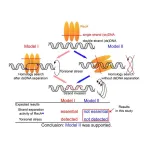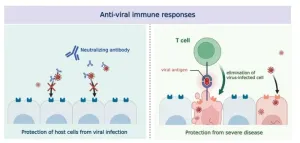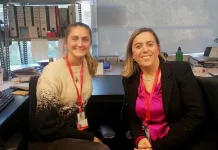(Press-News.org) About The Study: The Phoenix sepsis criteria for sepsis and septic shock in children were derived and validated by the international Society of Critical Care Medicine Pediatric Sepsis Definition Task Force using a large international database and survey, systematic review and meta-analysis, and modified Delphi consensus approach. A Phoenix Sepsis Score of at least 2 identified potentially life-threatening organ dysfunction in children younger than 18 years with infection, and its use has the potential to improve clinical care, epidemiological assessment, and research in pediatric sepsis and septic shock around the world.
Authors: R. Scott Watson, M.D., M.P.H., of the University of Washington in Seattle, is the corresponding author.
To access the embargoed study: Visit our For The Media website at this link https://media.jamanetwork.com/
(doi:10.1001/jama.2024.0179)
Editor’s Note: Please see the article for additional information, including other authors, author contributions and affiliations, conflict of interest and financial disclosures, and funding and support.
# # #
Media advisory: This study is being released to coincide with presentation at the Society of Critical Care Medicine’s Critical Care Congress.
Embed this link to provide your readers free access to the full-text article This link will be live at the embargo time https://jamanetwork.com/journals/jama/fullarticle/10.1001/jama.2024.0179?guestAccessKey=6db34f76-3a01-47d7-b29d-1b536f06c451&utm_source=For_The_Media&utm_medium=referral&utm_campaign=ftm_links&utm_content=tfl&utm_term=012124
END
International consensus criteria for pediatric sepsis and septic shock
JAMA
2024-01-21
ELSE PRESS RELEASES FROM THIS DATE:
CU researchers unveil modernized criteria for pediatric sepsis and septic shock
2024-01-21
An international research team led by Tell Bennett, MD, MS, professor of biomedical informatics and pediatric critical care at the University of Colorado School of Medicine, released new diagnostic criteria for sepsis in children this week, marking the first update to the pediatric sepsis definition in nearly two decades.
The updated criteria, presented at the 2024 Critical Care Congress of the Society for Critical Care Medicine (SCCM), will be utilized ...
A computerized decision support system significantly reduces high-risk drug combinations in Intensive Care patients
2024-01-21
A recent multicentre study led by Amsterdam UMC and conducted in nine Dutch Intensive Care Units (ICUs) has shown that tailoring a computerised decision support system (CDSS) to the ICU environment significantly reduced the number of high-risk drug combinations administered to ICU patients. It also improved monitoring ICU patients when avoiding such combinations was not possible, and reduced the length of patients’ stay in the ICU. This study is published today in The Lancet.
"Not more, but fewer and more relevant alerts by a CDSS make such a system more valuable for healthcare providers and patients," says Amsterdam ...
Scientists unravel key steps in the road to DNA repair
2024-01-20
Tokyo, Japan – Researchers from Tokyo Metropolitan University have been studying DNA repair by homologous recombination, where the RecA protein repairs breaks in double-stranded DNA by incorporating a dangling single-strand end into intact double strands, and repairing the break based on the undamaged sequence. They discovered that RecA finds where to put the single strand into the double helix without unwinding it by even a single turn. Their findings promise new directions in cancer research.
Homologous recombination (HR) is a ubiquitous biochemical process shared across all living things, including animals, plants, fungi, and bacteria. As we go about our daily ...
Study identifies new PD-1 immune checkpoint mechanism promoting merkel cell carcinoma growth
2024-01-19
Programmed cell death 1 (PD-1) is an important target for immune checkpoint inhibitor therapies that block its signaling and boost T-cell activity. PD-1 inhibitors have been approved for treating various types of cancer.
But PD-1 functions can vary between different cell and cancer types, either promoting or suppressing disease progression. Merkel cell carcinoma (MCC), a rare and aggressive form of skin cancer, responds well to immune checkpoint inhibitor therapy. However, it was previously unknown if MCC cells express PD-1 themselves, and unclear how exactly cancer cell-intrinsic ...
Vanderbilt chemist Ben Brown awarded $2.375M to develop nonaddictive painkillers with AI
2024-01-19
When Ben Brown, research assistant professor of chemistry, thinks about the opioid epidemic, he views the problem on a molecular level. Painkillers used legitimately in medicine, such as oxycodone, are highly addictive, but better understanding of how their molecules interact with proteins in the body could lead to the formulation of nonaddictive alternatives, he said.
In May, the National Institute on Drug Abuse awarded Brown $1.5 million over five years to further his work in this area. Brown, faculty affiliate of the Vanderbilt Center for Addiction Research and the Center for Applied Artificial Intelligence in Protein Dynamics, is developing artificial intelligence that ...
National champion tree program finds new home
2024-01-19
The National Champion Tree Program started 83 years ago at American Forests to discover the largest, living trees in the United States. Now, the program is moving from the organization’s headquarters to a new home in the School of Natural Resources at the University of Tennessee Institute of Agriculture (UTIA).
American Forests launched the Champion Tree Program in 1940. Its vision included establishing a nationwide laboratory for the study of forestry and trees. Being housed at Tennessee’s 1862 public land-grant university will advance the program’s understanding of big trees. “The National Champion Tree Program moving to UTIA means it can continue protecting ...
New AEM study evaluates potential disparities in restraint use in the emergency department at a minority-serving safety-net hospital
2024-01-19
Des Plaines, IL — A new study that contributes additional data to a growing body of evidence demonstrating disparities in restraint use in the emergency department (ED) has been published in the January issue of Academic Emergency Medicine (AEM), the peer-reviewed journal of the Society for Academic Emergency Medicine (SAEM). The study, titled Disparities in use of physical restraints at an urban, minority-serving hospital emergency department evaluates the association between race/ethnicity and the use of restraints in an ED population ...
CRISPR off-switches: A path towards safer genome engineering?
2024-01-19
Using CRISPR, an immune system bacteria use to protect themselves from viruses, scientists have harnessed the power to edit genetic information within cells. In fact, the first CRISPR-based therapeutic was recently approved by the FDA to treat sickle cell disease in December 2023. That therapy is based on a highly studied system known as the CRISPR-Cas9 genetic scissor.
However, a newer and unique platform with the potential to make large-sized DNA removals, called Type I CRISPR or CRISPR-Cas3, waits in the wings for potential therapeutic use.
A new study from Yan Zhang, ...
Evolution of the human immune system in the post-Omicron era
2024-01-19
It has been 4 years since the start of the COVID-19 pandemic. SARS-CoV-2 has yet to be eradicated and new variants are continuously emerging. Despite the extensive immunization programs, breakthrough infections (infection after vaccination) by new variants are common. New research suggests that human immune responses are also changing in order to combat the never-ending emergence of new SARS-CoV-2 variants. Specifically, it has been discovered the immune system that encountered breakthrough infection by the Omicron variant acquires enhanced immunity against future versions of the Omicron.
A team of South Korean scientists ...
First therapeutic target for preserving heart function in patients with pulmonary hypertension
2024-01-19
A team led by Dr. Guadalupe Sabio at the Centro Nacional de Investigaciones Cardiovasculares (CNIC) in Madrid has discovered a possible therapeutic target for pulmonary hypertension.
The study, published in the journal Science Advances, identifies the first therapeutic target that can be modulated to preserve cardiac function in pulmonary hypertension, providing hope in the fight against this rare but fatal disease for which there is currently no cure.
Pulmonary hypertension is a condition of elevated blood pressure in the arteries that carry deoxygenated blood to the lungs. This increased pulmonary blood pressure puts the heart under continuous strain ...
LAST 30 PRESS RELEASES:
Flaring black hole whips up ultra-fast winds
Study explores the link between newspaper preference and attitudes towards autism
Artificial turf in the Nordic climate – a question of sustainability
The hidden toll of substance use disorder: annual cost of lost productivity to US economy nearly $93 billion
Among psychologists, AI use is up, but so are concerns
Recycling a pollutant to make ammonia production greener
Common institutional ownership linked to less aggressive business strategies in Chinese firms
Energy and regional factors drive carbon price volatility in China’s emissions trading markets
Researchers from NUS Medicine and the Institute of Mental Health detect early brain changes linked to future psychosis development
Cryopreserved vs liquid-stored platelets for the treatment of surgical bleeding
Cost-effectiveness of cryopreserved vs liquid-stored platelets for managing surgical bleeding
Adaptive Kalman filter boosts BDS-3 navigation accuracy in challenging environments
Home-based monitoring could transform care for patients receiving T-cell redirecting therapies
Listening to the 'whispers' of electrons and crystals: A quantum discovery
Report on academic exchange (colloquium) with Mapua University
Sport in middle childhood can breed respect for authority in adolescence
From novel therapies to first-in-human trials, City of Hope advances blood cancer care at the American Society of Hematology (ASH) annual conference
Research aims to strengthen the security of in-person voting machines
New study exposes hidden Alzheimer’s 'hot spots' in rural Maryland and what they reveal about America’s growing healthcare divide
ASH 2025: Study connects Agent Orange exposure to earlier and more severe cases of myelodysplastic syndrome
ASH 2025: New data highlights promise of pivekimab sunirine in two aggressive blood cancers
IADR elects George Belibasakis as vice-president
Expanding the search for quantum-ready 2D materials
White paper on leadership opportunities for AI to increase employee value released by University of Phoenix College of Doctoral Studies
ASH 2025: New combination approach aims to make CAR T more durable in lymphoma
‘Ready-made’ T-cell gene therapy tackles ‘incurable’ T-cell leukemia
How brain activity changes throughout the day
Australian scientists reveal new genetic risk for severe macular degeneration
GLP-1 receptor agonists likely have little or no effect on obesity-related cancer risk
Precision immunotherapy to improve sepsis outcomes
[Press-News.org] International consensus criteria for pediatric sepsis and septic shockJAMA




